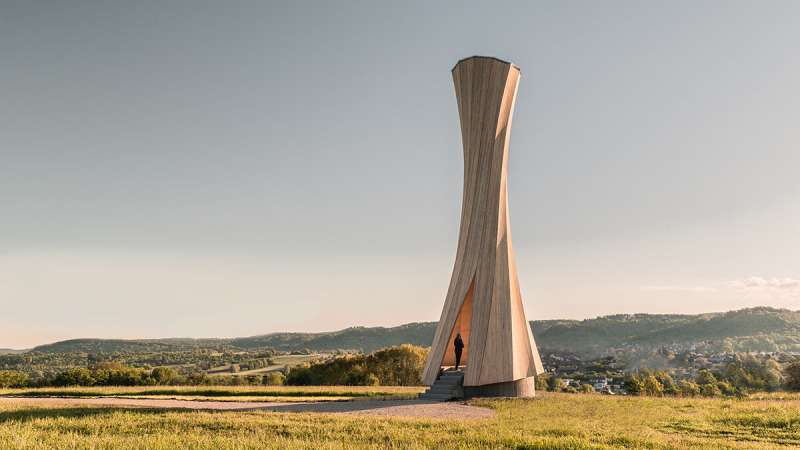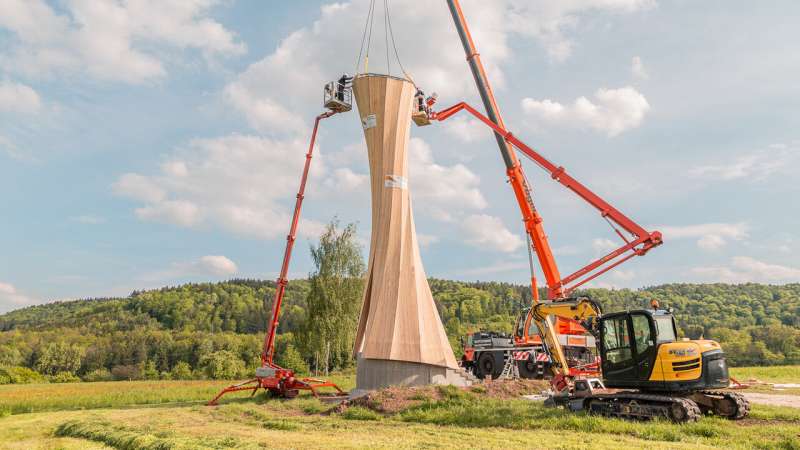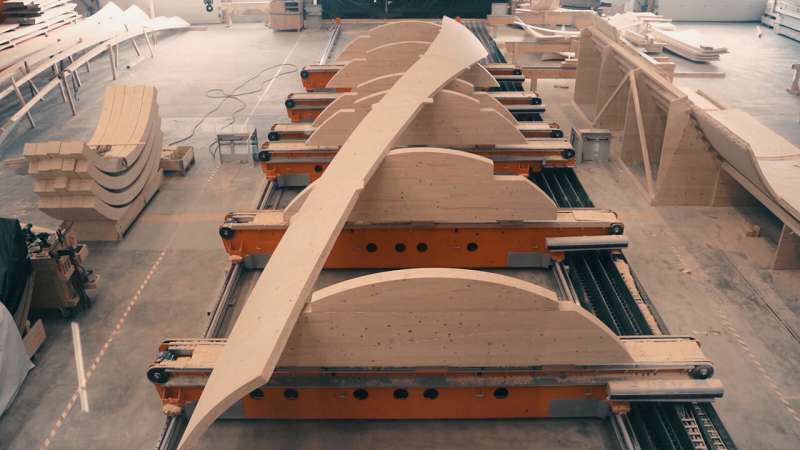June 12, 2019 weblog
Urbach Tower offers view of self-shaping architecture

Oh, those leaning towers are so yesterday. Tech-watching sites, rather, are talking about a tower that does not lean; it is just as interesting as it is a self twisting tower. This is the Urbach Tower.
Lucy Wang in Inhabitat: "The University of Stuttgart completed a nearly 47-foot-tall timber structure that gets its curvaceous form from the "self-shaping process" of its curved wood components."
The tower has a unique look and shows unique behavior with self-shaping wood. The team behind this project are from the Institute for Computational Design and Construction, and Institute of Building Structures and Structural Design, University of Stuttgart, along with other collaborations from industry and science sectors.
The ICD and ITKE described the method as a way of "programming" wood, said Dezeen. (As a university page explained, "in the same way that machines can be programmed to perform different movements, wood parts can be programmed to transform into predetermined shapes when dried."
Dezeen delivered praise for The University of Stuttgart as "renowned for its research into new materials and construction methods."
Talking about its "looks," think tree-like spiral construct with back-to-nature texture and color, a stunning landscape marker. The university site aptly referred to the tower as providing "a place of shelter, internal reflection and outward view by revealing stunning vistas and framing the landscape... It celebrates the innate and natural characteristics of self-shaped wood in its upwards spiraling shape."
As important, it shows what the future could hold for builders using wood. Could this tower reflect "a paradigm shift in timber manufacturing"?
Nick Lavars added context to this in New Atlas. "Not only is wood more sustainable than concrete or steel, contorting it into desired shapes through this method negates the need for energy-intensive mechanical forming that involves serious machinery, as the material itself does the heavy lifting."

That shift would mean away from "elaborate and energy-intensive mechanical forming processes that require heavy machinery to a process where the material shapes entirely by itself."
Inhabitat said "the Urbach Tower offers a more sustainable alternative to energy-intensive, mechanically formed structures."
This is not the first time that scientists explored shape-shifting material—that was done, usually with polymer, said Shazma Khan in Business Recorder, bending upon heat or moisture exposure.
The standout here is that they are making a twisting structure out of wood. Components are manufactured in a flat state yet autonomously transform into programmed curved shapes during drying.
Dezeen said this marks the first time that such a process has been used to construct a building.
What is that process?
Dezeen said the process "involves predicting how wood will shrink as it dries out. Based on this technique, the flat timber panels are designed to warp into the desired shape."
Newly added computational simulations for more accurate prediction were put into play, allowing the team to use moisture induced swelling and shrinking to design and program specific self-shaping movements at larger and larger scale.

"Moisture is usually bad news for timber, at least if you plan to use it for building purposes," said Lavars in New Atlas. In drying out, it can cause the material to crack and warp.
What type of wood did they use? They used spruce wood, sourced from Switzerland. A transparent coating protects the wood from UV radiation and fungi attacks.
On June 21st, ICD Research Associate Dylan Wood will give a lecture for the Design For Manufacture program at the Bartlett School of Architecture, University College London. From machine control to material programming – A paradigm shift to self-shaping design and manufacturing.
He explained the team's work in New Atlas. "By carefully understanding and digitally modeling the deformations that occur in the drying process we can arrange the wood before drying to produce specific deformations."
Reader reactions on Dezeen included these:
"I think the methodology and science behind it is a real mind-trip! Designing with the understanding that wood moves is one thing, but designing the final form based on predicting that movement – wow!"
"Fascinating. Material science has always been about properties, but to let the material show you where it wants to go is an entirely new and interesting engineering step."
More information: icd.uni-stuttgart.de/?p=23336
© 2019 Science X Network




















